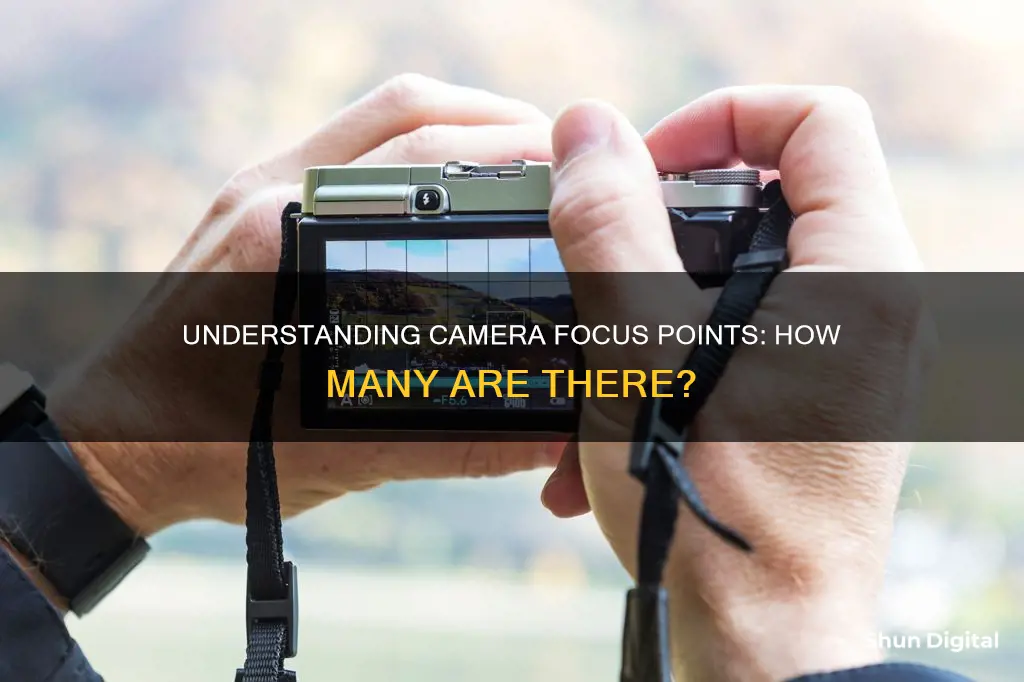
Focus points are what your camera uses to focus. They are the visual representation of what your camera is focusing on and appear as empty squares or dots on your camera's viewfinder or LCD screen. The number of focus points varies by camera model, with modern systems offering anywhere from a dozen to hundreds of points. More focus points generally enhance focusing capability, making it easier to track and maintain focus on a moving subject.
| Characteristics | Values |
|---|---|
| Purpose | Allow photographers to focus on composition and lighting without worrying about focus |
| Visual representation | Squares or dots on the camera's viewfinder or LCD screen |
| Number | 9-point, 45-point, 51-point, 60-point, 75-point, and more |
| Function | Help the camera focus on a specific part of the frame |
| Types | Standard, cross-type, dual cross, vertical, horizontal |
| Autofocus modes | Single-shot, continuous/tracking, AF-S, AF-C, AF-A, One-Shot, AI-Servo |
| AF area modes | Single-point, dynamic area, zone, 3D tracking |
What You'll Learn
- Autofocus points: the more you have, the more you can fine-tune your focusing
- Autofocus modes: single-shot for still subjects, continuous/tracking for moving subjects
- Active autofocus vs passive autofocus: active autofocus is rarely used
- AF-S and AF-C: AF-S locks focus, AF-C continuously acquires focus
- AF area modes: single-point, dynamic area, and 3D tracking

Autofocus points: the more you have, the more you can fine-tune your focusing
Autofocus points, or AF points, are a visual representation of what your camera is focusing on. They usually appear as rectangles or circles in your viewfinder or as empty squares or dots on your camera's LCD screen.
When purchasing a camera, you may come across specifications such as 9-point or 51-point AF systems. This refers to the number of AF points a camera has. The more points, the more finely you can tune your focusing.
Cameras with more autofocus points are better at tracking and maintaining focus on moving subjects. This is particularly useful for nature photographers who frequently engage in action photography.
Cameras with fewer autofocus points may struggle to achieve and maintain accurate focus as the gaps between each point are larger. These areas of the scene not covered by AF points can be thought of as "dead zones".
It's important to note that having more autofocus points does not mean that more of your image will be in focus. There is only one plane that is in focus, and everything in front of and behind that plane will be progressively blurrier.
Different types of AF points include vertical, horizontal, and cross-type. Cross-type AF points are more accurate and better at retaining focus but are also more expensive.
Keeping Your Camera Focused on a Jib Crane
You may want to see also

Autofocus modes: single-shot for still subjects, continuous/tracking for moving subjects
Single-shot autofocus is best suited for stationary subjects. It is also known as AF-S (Nikon), One-Shot AF (Canon), and Single-Shot AF (Sony). When using this mode, the autofocus stops as soon as something in the frame comes into focus at the selected AF points. The focus then remains locked in place until the shutter is fired or autofocus is reactivated by releasing the shutter button. This mode is ideal for posed portraits, still lifes, and architecture photography.
Continuous autofocus, on the other hand, is designed for capturing moving subjects. It is also referred to as AF-C (Nikon and Sony), AI Servo AF (Canon), and Continuous AF (Sony). When using this mode, the camera continually adjusts the focus to ensure that whatever is in the active AF point remains sharp. As long as the shutter button is held halfway down, the camera will keep working to ensure that whatever is in the AF zone stays sharp when the shutter is fired. This mode is useful for sports photography, wildlife photography, and capturing moving subjects like runners or vehicles.
Single-shot autofocus is generally more battery-efficient than continuous autofocus, which requires more processing power and lens adjustments.
The Rarity of Epson R-D1 Rangefinder Cameras
You may want to see also

Active autofocus vs passive autofocus: active autofocus is rarely used
A camera's autofocus system automatically adjusts the camera lens to focus on the subject, and can mean the difference between a sharp photo and a missed opportunity. There are two types of autofocus (AF) systems: Active AF and Passive AF.
The Active AF system works by emitting a signal (usually a red beam) to illuminate and/or estimate the distance to the subject. The camera then uses this information to adjust the focus of the lens accordingly. Active AF is useful in low-light environments where passive AF struggles. However, it is limited to stationary subjects and only works for close subjects.
On the other hand, the Passive AF system does not emit any signals. Instead, it relies on "Phase Detection" or "Contrast Detection" methods (or a combination of both) for detecting contrast in the scene. Passive AF can be further divided into two types: Phase Detection AF and Contrast Detection AF.
Phase Detection AF uses an array of microlenses to split the incoming light into a pair of images. The distance between these images is measured to determine how far the lens needs to adjust its focus. This type of AF is very fast, making it ideal for tracking fast-moving subjects.
Contrast Detection AF, on the other hand, relies on software algorithms that scan the scene for edge detail and rapidly adjust the lens' focus from foreground to background until the subject is sharp. This method is generally slower but can be more reliable and accurate in low-light conditions.
Most modern DSLR and mirrorless cameras use a combination of Phase and Contrast Detection AF, known as Hybrid AF, to take advantage of both systems in different environments.
While Active AF has its advantages, it is rarely used compared to Passive AF due to its limitations. Active AF is only suitable for stationary, non-moving subjects and has a limited range, whereas Passive AF is more versatile and can be used in a wider range of situations. Additionally, Passive AF has improved over time with the development of Hybrid AF systems, which offer faster and more accurate results. Therefore, camera manufacturers and photographers often prefer Passive AF over Active AF.
The Argus Coated Sintar Camera: A Historical Perspective
You may want to see also

AF-S and AF-C: AF-S locks focus, AF-C continuously acquires focus
When it comes to autofocus points, modern cameras offer photographers a range of options to ensure they get the perfect shot. The number of autofocus points available varies between cameras, with some offering 9-point or even 51-point autofocus systems. The more autofocus points a camera has, the more precisely you can adjust your focusing.
Autofocus points are a visual representation of what your camera is focusing on, usually appearing as empty squares or dots on your viewfinder or LCD screen. They allow photographers to experiment with different focusing methods and drastically change the look of each shot.
Different camera brands have different autofocus modes, but two of the most common are AF-S (AF-Single) and AF-C (AF-Continuous). AF-S locks focus onto a subject once it has been achieved and keeps it locked as long as you keep the shutter button half-pressed. This mode is best used when photographing stationary subjects or subjects that don't move, such as flowers or portraits.
On the other hand, AF-C is ideal for photographing moving subjects. This mode will keep refocusing on the subject as they move, as long as you keep the shutter button half-pressed. AF-C is perfect for sports or wildlife photography, or any situation where your subject is in motion.
Both AF-S and AF-C have their advantages and are suited for different types of photography. By understanding how these autofocus modes work, photographers can better utilise their camera's capabilities to capture stunning images.
Understanding DC Camera Tickets and Fines
You may want to see also

AF area modes: single-point, dynamic area, and 3D tracking
Single-point AF-area mode is a camera setting that allows you to select a single focus point for static elements within a scene. As long as you keep the subject framed over this point and are using AF-C (continuous autofocus), the camera will automatically adjust the focus to keep the image sharp. Single-point AF is the best focus area mode for still subjects.
Dynamic AF-area mode is when you manually select your focus point, and if the subject moves, the camera uses this point and the surrounding points to keep the subject sharp. You only have to keep your focus button pressed and the camera will continue focusing. Dynamic AF is the best AF area mode for wildlife and sports/action photography.
In 3D-tracking mode, you initially pick the AF point and the camera will automatically activate as many focus points as needed to track subject movement. The 3D-tracking method will use all available focus points on the camera to track your subject, while the dynamic AF-area mode divides the focus points into "zones", activating only the surrounding focus points. 3D-tracking is efficient for tracking subjects like a flying bird in a clear sky.
The Exclusive Club of 50th Anniversary Camaros
You may want to see also
Frequently asked questions
Autofocus points are what you use to determine where the camera will focus. They are the rectangles or circles that you see when you look through your viewfinder.
The number of autofocus points offered by a camera depends on the specific model. More focus points are pretty much always better, which is why camera focus point counts are continuously increasing. Modern systems offer from a dozen to hundreds of points.
There are vertical and horizontal autofocus points, which detect contrast on vertical and horizontal lines, respectively. There are also cross-type autofocus points, which are more advanced and accurate as they analyse both vertical and horizontal lines.
You can normally select either one specific point or all points at once for autofocusing. You can toggle between AF points using the wheels or arrow keys on the back of your camera.







